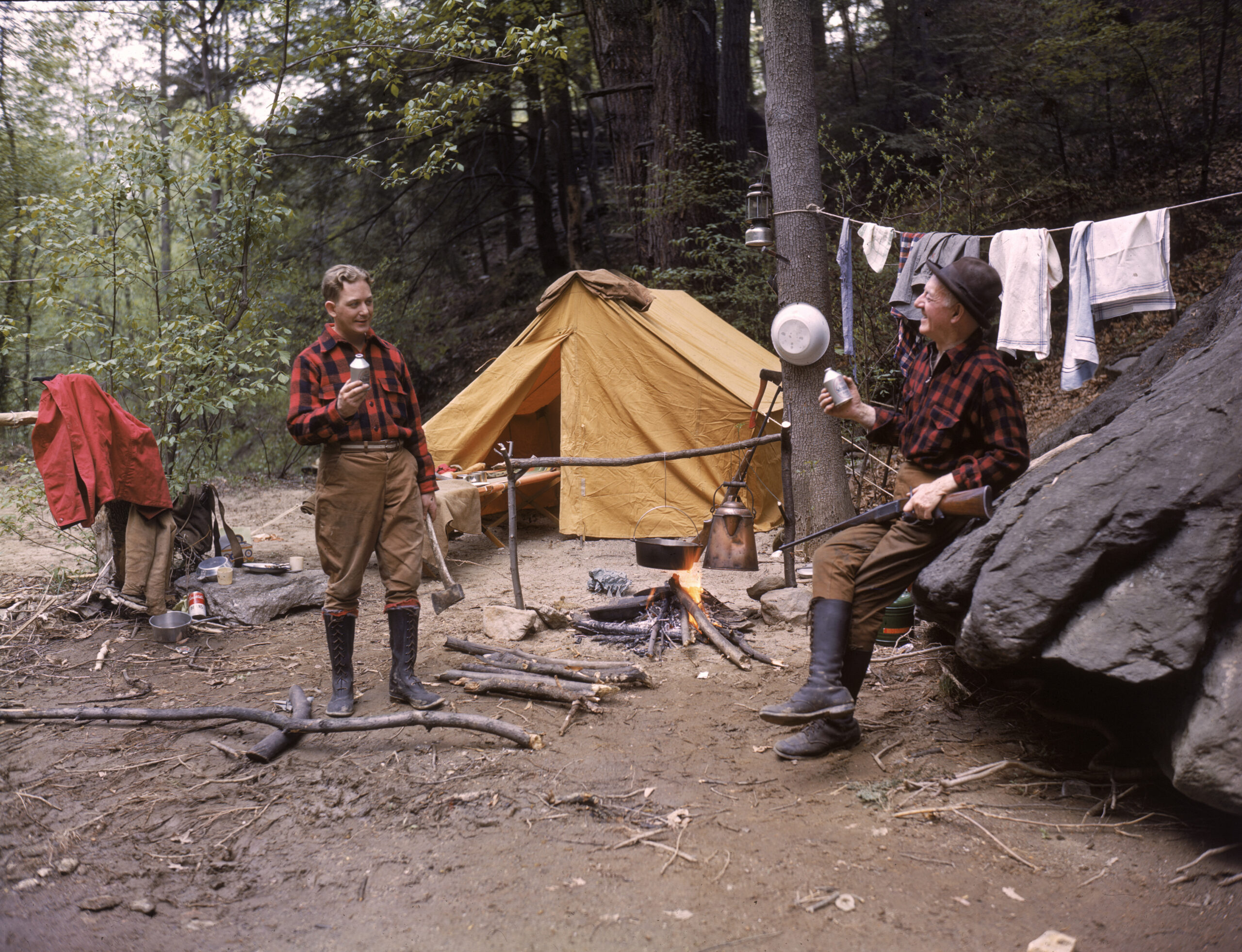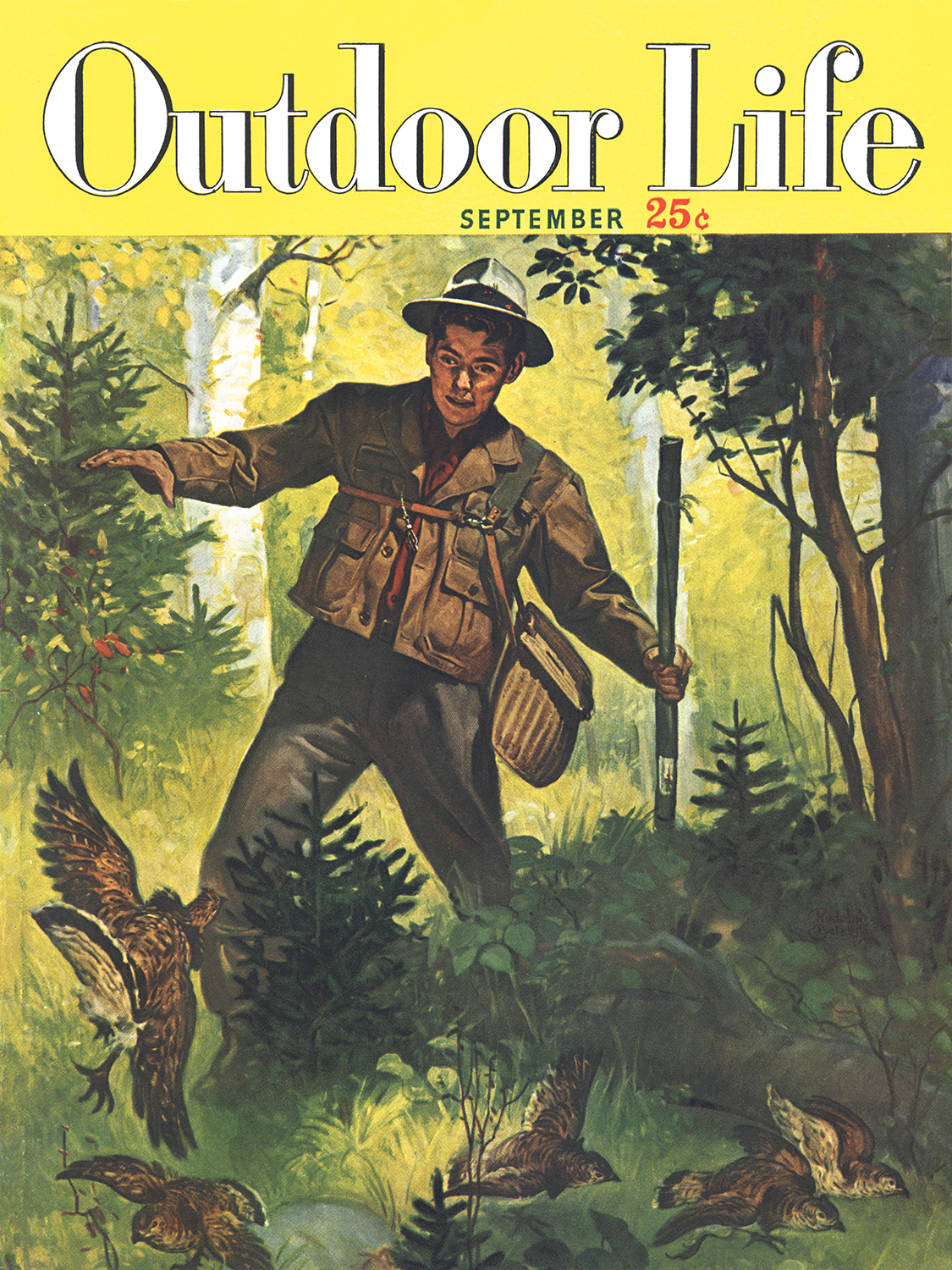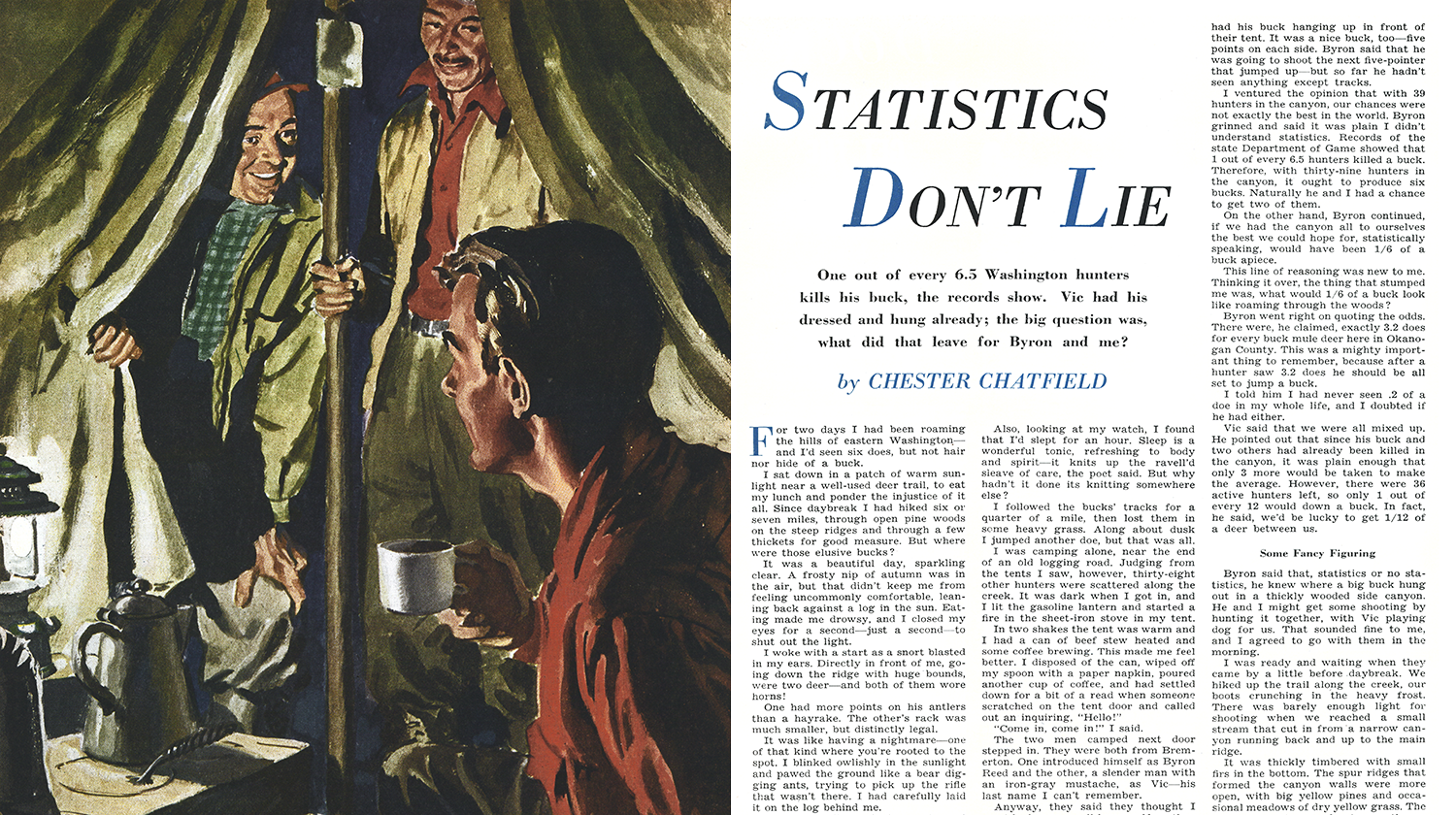This story, “Statistics Don’t Lie,” originally ran in the September 1949 issue of Outdoor Life.
FOR TWO DAYS I had been roaming the hills of eastern Washington—and I’d seen six does, but not hair nor hide of a buck.
I sat down in a patch of warm sunlight near a well-used deer trail, to eat my lunch and ponder the injustice of it all. Since daybreak I had hiked six or seven miles, through open pine woods on the steep ridges and through a few thickets for good measure. But where were those elusive bucks?
It was a beautiful day, sparkling clear. A frosty nip of autumn was in the air, but that didn’t keep me from feeling uncommonly comfortable, leaning back against a log in the sun. Eating made me drowsy, and I closed my eyes for a second—just a second—to shut out the light.
I woke with a start as a snort blasted in my ears. Directly in front of me, going down the ridge with huge bounds, were two deer—and both of them wore horns!
One had more points on his antlers than a hayrake. The other’s rack was much smaller, but distinctly legal.
It was like having a nightmare—one of that kind where you’re rooted to the spot. I blinked owlishly in the sunlight and pawed the ground like a bear digging ants, trying to pick up the rifle that wasn’t there. I had carefully laid it on the log behind me.
By the time I was finally awake and had located my gun, the bucks were out of sight, though I could still hear them crashing through a thicket. Investigating, I discovered that they had walked up to within forty feet of me before the big fellow in the lead got my scent and snorted as he whirled away.
Also, looking at my watch, I found that I’d slept for an hour. Sleep is a wonderful tonic, refreshing to body and spirit—it knits up the ravell’d sleave of care, the poet said. But why hadn’t it done its knitting somewhere else?
I followed the bucks’ tracks for a quarter of a mile, then lost them in some heavy grass. Along about dusk I jumped another doe, but that was all.
I was camping alone, near the end of an old logging road. Judging from the tents I saw, however, 38 other hunters were scattered along the creek. It was dark when I got in, and I lit the gasoline lantern and started a fire in the sheet-iron stove in my tent.
In two shakes the tent was warm and I had a can of beef stew heated and some coffee brewing. This made me feel better. I disposed of the can, wiped off my spoon with a paper napkin, poured another cup of coffee, and had settled down for a bit of a read when someone scratched on the tent door and called out an inquiring, “Hello!”
“Come in, come in!” I said.

The two men camped next door stepped in. They were both from Bremerton. One introduced himself as Byron Reed and the other, a slender man with an iron-gray mustache, as Vic—his last name I can’t remember.
Anyway, they said they thought I must be lonesome all by myself, so they dropped in to chew the fat. As a matter of fact I don’t get lonesome, but I was glad to have them just the same, and I got them some coffee. I haven’t seen them since that trip, but two better fellows would be hard to find anywhere.
Vic was feeling pretty good, for he had his buck hanging up in front of their tent. It was a nice buck, too—five points on each side. Byron said that he was going to shoot the next five-pointer that jumped up—but so far he hadn’t seen anything except tracks.
I ventured the opinion that with 39 hunters in the canyon, our chances were not exactly the best in the world. Byron grinned and said it was plain I didn’t understand statistics. Records of the state Department of Game showed that 1 out of every 6.5 hunters killed a buck. Therefore, with thirty-nine hunters in the canyon, it ought to produce six bucks. Naturally he and I had a chance to get two of them.
On the other hand, Byron continued, if we had the canyon all to ourselves the best we could hope for, statistically speaking, would have been 1/6 of a buck apiece.
This line of reasoning was new to me. Thinking it over, the thing that stumped me was, what would 1/6 of a buck look like roaming through the woods?
Byron went right on quoting the odds. There were, he claimed, exactly 3.2 does for every buck mule deer here in Okanogan County. This was a mighty important thing to remember, because after a hunter saw 3.2 does he should be all set to jump a buck.
I told him I had never seen .2 of a doe in my whole life, and I doubted if he had either.
Vic said that we were all mixed up. He pointed out that since his buck and two others had already been killed in the canyon, it was plain enough that only 3 more would be taken to make the average. However, there were 36 active hunters left, so only 1 out of every 12 would down a buck. In fact, he said, we’d be lucky to get 1/12 of a deer between us.
Some Fancy Figuring
Byron said that, statistics or no statistics, he knew where a big buck hung out in a thickly wooded side canyon. He and I might get some shooting by hunting it together, with Vic playing dog for us. That sounded fine to me, and I agreed to go with them in the morning.
I was ready and waiting when they came by a little before daybreak. We hiked up the trail along the creek, our boots crunching in the heavy frost. There was barely enough light for shooting when we reached a small stream that cut in from a narrow canyon running back and up to the main ridge.
It was thickly timbered with small firs in the bottom. The spur ridges that formed the canyon walls were more open, with big yellow pines and occasional meadows of dry yellow grass. The ridges were steep, and not more than a quarter of a mile apart.
Vic planned our strategy. “I’ll work my way up the canyon through the thickets along the creek, staying toward the left,” he said. “You fellows both go up the right-hand ridge, one near the bottom and the other on top. The man on top will be able to watch the opposite slope as well as the ridge he’s on, and in some places it’s close enough to shoot across the canyon.”
Inasmuch as I had a scope on my rifle, I was given the place of honor on the open ridgetop. This was more than generous of Byron, as there was slim chance of getting any shooting down in the thick woods. However, I had to make good any shots that offered.
“We’ll move slowly,” Vic warned. “Take it easy, and zigzag enough to cover the ground. We’ll meet at the head of the canyon in about three hours.”
The ridge crest I was to travel was mostly as open as a park, and varied in width from 10 to 200 feet. It rose steeply from the valley floor all the way back to the big main ridge, about two miles distant and 3,000 feet higher in elevation.
As I climbed I kept zigzagging back and forth to look down into the canyons and to the opposite ridges on both sides. With so much good country and a couple of men prowling the thicket in the bottom, it seemed there was bound to be something doing before long.
Sure enough, after I had gone half a mile two sleek does came trotting up out of the thicket and climbed the steep side of the ridge. I stood still and they never saw me at all. They crossed the ridge about 100 yards ahead of me, pausing to look back over their shoulders. Undoubtedly Byron had kicked them out.
That really put me on my toes. Counting the doe I had seen the evening before, I had now seen three does since the last buck. According to Byron the next deer should be 2/10 of a doe, but I still didn’t believe this. I thought the next deer would be a buck. I pussyfooted along up the ridge with my rifle ready for business.
I saw a fair number of tracks along the ridge, but all of them small, made either by does or little bucks. This brought a discouraging idea to my mind. The state Department of Game, as quoted by Byron, said there was one buck to every 3.2 does; but what if half the bucks were spikehorns or fawns? That would cut the number of legal bucks down to one for every 6.4 does. I’d have to find 3.4 more does besides the three I had already seen before I could expect a buck.
The question remained unresolved as I continued to climb slowly up the ridge, for I saw no deer of either sex. Finally the canyon began to narrow, and at last it pulled together into a steep open basin, like the inside of half a cup, where it joined the main ridge.
I sat down with my back against a big yellow pine to wait for Byron and Vic. It was pleasant to relax and look around at the still woods, with the bright sunshine on the greens and and browns and yellows. This time, however, I didn’t go to sleep.
For 10 minutes there wasn’t a sound except the occasional chatter of a squirrel. Then, across the basin and about 200 yards distant, a deer trotted out of the thicket and started up the ridge.
I wasn’t entirely sure of my statistics at this point, but I thought it might be a buck as I pulled up my field glasses for a look. It was a big doe.
And while I watched, another unusually large doe came trotting out. “Oh statistics,” I groaned to myself, “what are you doing to me?”

I watched the two does, which were both trotting about as fast as they could go without bounding. And then the old granddaddy of all the deer tribes came out of the thicket and followed the does. His antlers thrust up in the sunlight in a big yellow rack, and he too was hurrying along. I suspected that Byron or Vic was close behind.
The buck looked a lot farther away when I dropped my glasses and leveled the gun. It was exceedingly hard to hold the post on him as he ran across the uneven ground. “Take it easy,” I cautioned myself. “You’ve got thirty seconds or more before he’ll be out of sight, and you can fire every cartridge in the rifle.”
I didn’t want to shoot him in the rump, which was mostly all that I could see, so I held high, trying to hit him in the back between his shoulders, or in the neck.
At the crack of the rifle the big buck went down instantly, rolled over two or three times, hit a tree, and lay there without movement. I grinned with relief and delight. Right through the neck, I decided.
I Got the Shock of My Life
Down in the thicket Byron called out, asking what I was shooting at. I told him I had a big buck down on the opposite ridge, and I would sit and watch while he walked over. I was peering into the thicket trying to locate Byron, and when I looked up I got the shock of my life.
The buck had his head in the air and was struggling to his feet!
I yelled to Byron, and slammed another shot at the buck. I was badly rattled, and missed him clean. He wasn’t running—just standing broadside to me with his head hanging down. I pounded another cartridge into the chamber, grabbed a deep breath, and carefully squeezed the trigger. The big buck arched his back like a cat as the bullet went through his ribs. But instead of collapsing he suddenly started down into the thicket with long bounds.
Three jumps and he was out of sight. I was vastly cheered up by the heavy report of Byron’s rifle. The shots blasted out one after another as I scrambled down into the thicket.
A few minutes later Byron and I were standing over the buck, who had finally given up. Byron had put three or four bullets through his ribs behind the shoulder, close to my second hit.
It was easy to see where my first shot had gone. It had struck just at the base of one antler, knocking off the antler and temporarily stunning the buck. Statistically speaking it was the sort of thing that might happen about once in a million times.
The buck was really big, with five points on one side and six on the other—Byron climbed up the hill and found the broken antler. Vic came along while we were dressing out the deer, and we had it in camp before dark.
It was easy to see where my first shot had gone. It had struck just at the base of one antler, knocking off the antler and temporarily stunning the buck.
Two more hunters in the canyon had shot bucks that day. Since that made the full statistical quota of six bucks for the thirty-nine hunters, Byron and I decided there was no use hunting any longer. Besides, we were satisfied to cut the big buck in two and each take half.
Byron said we should go around and tell the thirty-three luckless hunters that it was all over and they might as well go home. But I decided that maybe we hadn’t better say anything. After all, they were having a good time just hunting. In addition, if one of them felt that the statistics of this particular canyon were too much for him, he could always hike over into the next canyon and try hunting for 1/6 of a buck.
You see, I was beginning to have a greater appreciation of statistics. After all, it was the first time that I had ever killed half of a buck.
Read more OL+ stories.
